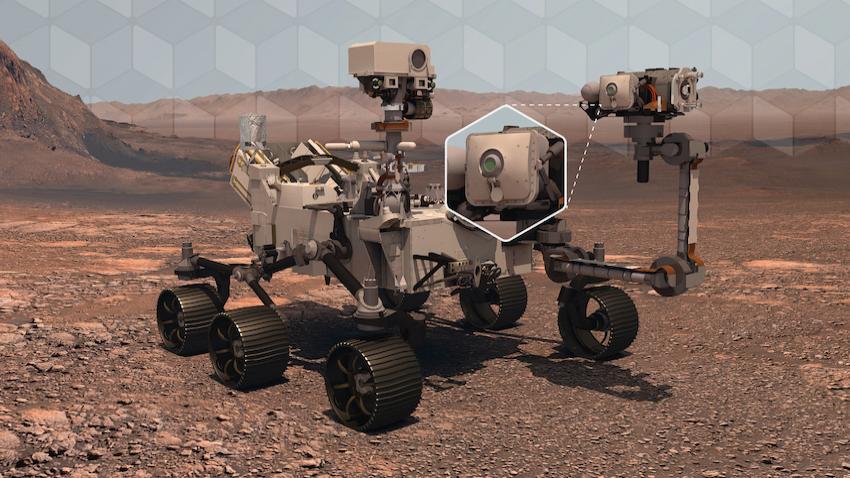
New Algorithm Perseveres in Search for Data Anomalies on Mars
Searching for evidence of life on Mars is making an impact here on Earth. One way this is being achieved is through development of data science tools successfully tested on the Mars Perseverance rover, which could be applied to interpret large, complex datasets on our own planet.
In a recent paper, a collaborative team of School of Computational Science and Engineering (CSE) researchers and NASA Jet Propulsion Laboratory (JPL) scientists introduce a design methodology, called ISHMAP, to develop new data anomaly detection models.
Though implemented on the Perseverance rover as it explores for new discoveries on the Red Planet, ISHMAP’s greater impact will be its applicability for terrestrial life here at home who work in the rocketing field of scientific data science.
“We have shown that collaboratively framing a data science problem with the relevant domain experts may be much more important than the actual data modeling when it comes to the ultimate impact of a model,” said Austin Wright, a School of CSE Ph.D. student. “That is to say, really working hard to precisely form the right question is, in many ways, more important than the model used to try and answer it.”
ISHMAP stands for Iterative Semantic Heuristic Modeling of Anomalous Phenomena. In essence, ISHMAP is a process for scientists and researchers to produce natively interpretable anomaly detection models.
The framework is the culmination of more than 30 months of collaborative research between CSE and JPL through Wright’s internship.
Here, the ISHMAP group partnered with the NASA team that manages Perseverance’s Planetary Instrument for X-Ray Lithochemistry (PIXL) instrument, a fluorescence spectrometer that studies elemental composition data of the Martian surface.
The highlight of ISHMAP’s development is a highly accurate spectral anomaly algorithm that resulted in a 93.4% accuracy rate when detecting diffraction anomalies. What started as a yearlong field deployment of the toolkit is now a regular component of the PIXL team’s workflow.
In fact, more than 97 NASA and NASA-affiliated scientists around the globe currently use a visualization tool embedded with the algorithm, thus proving itself as a key contributor in finding discoveries on Mars and elsewhere in our galaxy.
“ISHMAP can provide a strong structure to make sure scientists know what the model is doing and is guaranteed to be addressing something that they are interested in,” Wright said. “By contributing through the whole process, they have built-in levels of trust and ownership rather than just having some extra feature foisted upon them.”

The ISHMAP team joining Wright includes his advisor, School of CSE Associate Professor Polo Chau, as well as Adrian Galvin and Scott Davidoff from JPL. Peter Nemere, a programmer at Queensland University of Technology, also co-authored the paper.
The ISHMAP algorithm analyzes anomalies in crystal structures. These reveal aspects of geological and geochemical history that indicate suitability of life, such as past presence of water and essential minerals. This is a specific component of the PIXL instrument that searches for elemental traces of ancient microbial life on Mars in datasets collected in surveys, scans, and samples.
As scientific datasets grow larger and more complex, so too do the methods used to find anomalies. Existing anomaly detection research primarily relies on deep learning methods, but these tend to lack nuance and interpretability, which are vital to scientific inquiry.
ISHMAP bridges methodologies from artificial intelligence (AI) and human-computer interaction (HCI) into a framework for scientific researchers to use in designing more effective and interpretable anomaly detection tools.
An important early stage in the ISHMAP process was an 18-month-long formative design study between the ISHMAP group and NASA’s PIXL team. This defined the design goals needed to enhance PIXL.
To accomplish its mission, PIXL needed an algorithm that focused on raw data over processed data, robustness to operate under a limited amount of ground truth data, and enhanced ability to interpret and differentiate different kinds of anomalies.
Buy-in from users proved to be a key step in the early stages of the methodology to understand research problems and to integrate with existing model techniques. This way, ISHMAP produces an effective anomaly detection algorithm custom made to meet end-user needs.
To help spread the word about ISHMAP and attract more scientific users, Wright represented the group by presenting their research at the 28th Annual Conference on Intelligent User Interfaces (IUI 2023).
An Association for Computing Machinery conference held March 27 – 31 in Sydney, IUI 2023 is a premier international forum reporting outstanding research at the intersection of HCI and AI to further develop user interfaces.
“I think that researchers can consider using ISHMAP simply because these kinds of collaboration between data scientists and domain scientists are difficult,” Wright said. “A resource like ISHMAP can give structure to both parties, and make the whole process easier and more likely to result in good science.”
As computing revolutionizes research in science and engineering disciplines and drives industry innovation, Georgia Tech leads the way, ranking as a top-tier destination for undergraduate computer science (CS) education. Read more about the college's commitment:… https://t.co/9e5udNwuuD pic.twitter.com/MZ6KU9gpF3
— Georgia Tech Computing (@gtcomputing) September 24, 2024


